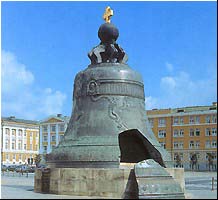|
| 
Tsar Bell and Tsar CannonTsar Bell
On a stone base at the foot of Ivan the Great is the largest bell in the
world. It was cast in the Kremlin by the master Ivan Motorin and his son
Mikhail. In all eighty-three people helped to cast the bell and about
two hundred assisted with its manufacture and decoration.
 The Motorins' creation was ill-fated, however. After casting the Tsar
Bell remained in the moulding pit for two years. In 1737 a terrible fire
broke out in Moscow and spread to the Kremlin buildings. When the flames
on the scaffolding around the bell were being extinguished, water fell
on the bell itself. The difference in temperature caused it to crack and
a huge piece weighing 11.5 tons broke off. In 1836 the Tsar Bell was
lifted up and placed on a stone pedestal. The Motorins' creation was ill-fated, however. After casting the Tsar
Bell remained in the moulding pit for two years. In 1737 a terrible fire
broke out in Moscow and spread to the Kremlin buildings. When the flames
on the scaffolding around the bell were being extinguished, water fell
on the bell itself. The difference in temperature caused it to crack and
a huge piece weighing 11.5 tons broke off. In 1836 the Tsar Bell was
lifted up and placed on a stone pedestal.
The bell weighs 200 tons and is 6.14 metres high with a diameter at the
base of 6.6 metres. Its sides are adorned with fine reliefs showing Tsar
Alexis, son of Michael, and his wife Anne, as well as inscriptions
relating the history of this remarkable specimen of Russian metalwork.
Tsar Cannon
A little further off, towards the Trinity Tower, stands the famous Tsar
Cannon on a decorative gun-carriage. In the sixteenth century no country
in the world had cannons like this. It weighs 40 tons and the barrel is
5 metres 34 centimetres long and 15 centimetres wide with an 890
millimetre calibre.
 The Tsar Cannon was made of bronze by the master Andrei Chokhov at the
Moscow cannon foundry. It was intended to defend the Kremlin Saviour
Gate. But the cannon's fate was similar to that of the bell. Just as the
latter never rang, so the Tsar Cannon never fired, although it was
intended for military use.
The Tsar Cannon was made of bronze by the master Andrei Chokhov at the
Moscow cannon foundry. It was intended to defend the Kremlin Saviour
Gate. But the cannon's fate was similar to that of the bell. Just as the
latter never rang, so the Tsar Cannon never fired, although it was
intended for military use.
The decorative gun-carriage on which the cannon stands was made of iron
in 1835, as were the hollow iron cannon-balls. |
 | |
| |
|
|
 |
|


